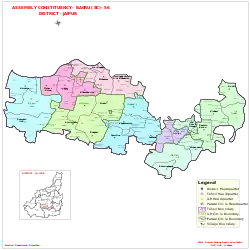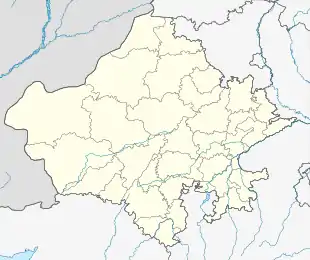Bagru
Bagru is a city and a municipality in Jaipur district (Tehsil Sanganer) in the state of Rajasthan, India. It is locatted at a distance of 32 km from Jaipur, on Jaipur-Ajmer Road.
Bagru | |
|---|---|
 Assembly map of Bagru constituency in Rajasthan. | |
 Bagru Location in Rajasthan, India | |
| Coordinates: 26.82°N 75.55°E | |
| Country | |
| State | Rajasthan |
| District | Jaipur |
| Elevation | 341 m (1,119 ft) |
| Population (2011) | |
| • Total | 31,229 |
| Languages | |
| • Official | Dundhari, Hindi |
| Time zone | UTC+5:30 (IST) |
| ISO 3166 code | IN-RJ |
Demographics
At the 2011 India census,[1] Bagru had a population of 31,229. Males constituted 52% of the population and females 48%. Bagru had an average literacy rate of 71.43%, lower than the national average of 74.04%, but higher than the state average of 66.11%; with 66% of the males and 34% of females literate. 18% of the population were under 8 years of age.
Economy
Bagru is known for natural dyes and hand block printing. Bagru is the place of Raiger and Chhipa community. Chhipas are involved in fabric printing tradition for over 100 years.The Raigers are involved in processing and manufacturing of leather and their products (like boots, mochdi, Rajasthani Jutee and other leather goods). The Raigers export raw leather (semi processed) to big leather companies and also sell in local market (Hatwara,Jaipur). Bagru is also known for natural dyeing, indigo dyeing and wooden hand block printing over textile articles.
The famous Jugal Darbar temple is located in Bagru. Here, an annual "Mela" (fair) is organized by the Bagda community which is attended by hundreds of people from neighbouring villages. This is place of peace and unites all communities.
Bagru also has a fort (private property) in heart of town which is normally open for public on Gangaur Festival.
Bagru is most famous for its typical wooden hand block prints.[2] These prints of Bagru are acclaimed all over India,[3] and are particularly known as "Bagru prints". The Prints of Bagru, unlike other prints, involve a different kind of printing. The unique method for printing employs wooden block in it. In the process, the desired design is engraved on the wooden block first and then the carved block is used for replicating the design in the preferred color on the fabric.
Chippa Mohalla (Printer's quarter) is the area for those, who are interested in textile printing. One can walk into the quarter, where people are always engrossed with dyes and blocks. The three-centuries-old tradition of block printing is kept alive with the efforts of Bagru artisans. Keeping the convention, these artisans smear the cloth with Fuller's earth got from the riverside and then dip it in turmeric water to get the habitual cream color background. After that, they stamp the cloth with designs using natural dyes of earthly shades.
Even today, artisans use traditional vegetable dyes for printing the cloth. Like, the color blue is made from indigo, greens out of indigo mixed with pomegranate, red from madder root and yellow from turmeric. Usually Bagru prints have ethnic floral patterns in natural colors. Bagru prints form the essential part of the block printing industry of Rajasthan. The village fabricates some of the bed covers and other materials. Nowadays this printing business is under crisis due to water crises and improper care by State Government where incentives based schemes are not available. It required a channel market to spread the popularity of handmade bedsheets under cluster program. There is no specific industrial zone to process the printing and export. All is depending on Sanganer based big traders and speculators. Even in entire town there is not a water treatment plant and chemical water is releasing through municipal councils (Nagar Palika) drainage lines towards the end of town.
There are many educational institutes, including the Government High Secondary School, Mahila Mahavidyalay (girls only), Chaudhary Public School, Waris international School (since 2002), MG English International School Bagru (founded by Manish Gupta). The Government High School gave the various brilliant students who performed in most competitions for Engineering, and Medical Examinations. Rather than this school others are just place of modern education. In 2015 there are approximately 10 private schools are running in Bagru.
References
- "Census of India 2001: Data from the 2001 Census, including cities, villages and towns (Provisional)". Census Commission of India. Archived from the original on 16 June 2004. Retrieved 1 November 2008.
- Murthy, Vaibhavi (10 July 2020). "All about traditional block Print Fabrics". CTC Jaipur. Retrieved 20 October 2020.
- Murthy, Vaibhavi (10 July 2020). "All about Bagru Dabu Print Fabrics". CTC Jaipur. Retrieved 20 October 2020.